The Mona Lisa portrait called Gioconda in Italian is the most popular, talk about, visited, written about, and valuable painting. Created in 1503-1506 by the Italian painter Leonardo da Vinci, it is now placed in Louvre Museum in France, Paris.
In 1517, Leonardo da Vinci moved to France in Château du Clos Lucé, when the French king, King Francis offered him a job as a court painter, engineer, and architect. At that time da Vinci brought only one painting with him, which was the Mona Lisa. He kept the portrait with him, until his last breath.
Advanced techniques
Mona Lisa is one of the most advanced paintings of its time due to the technique of Leonardo. Leonardo was a genius who made a lot of research on muscles movements to achieve this distinctive 3-dimensional art. He used techniques like sfumato to blend the eyes and mouth of the painting so soft that she looks alive. It was the first painting ever to use aerial perspective behind Mona Lisa that made her pop out. If you look into her eyes you will see her eyes following you and you will see her smiling but if you look at her lips, she is not smiling. If you don’t pay attention well you won’t see her veil which now you’ll see. Leonardo knew how to manipulate shadows to create those illusions.
Theories of the real Mona Lisa
There were many theories of who the woman in the portrait might be, but none of these theories has been proven hundred per cent. However, some theories have more evidence than others. Mona Lisa is more than five hundred years ago and it is still one of the most advanced paintings ever made, but we don’t know-how, for whom, and why it was created. Some believe that the sitting woman in the painting is Leonardo da Vinci himself portrait as a woman. Some say she is the woman portrait of da Vinci’s assistant Salai. While many other noblewomen were thought to be her, but the one with the most evidence is Lisa del Giocondo.
Is Salaì, the assistant of da Vinci the real Mona Lisa
Gian Giacomo Caprotti da Oreno known as Salaì was the assistant of Leonardo da Vinci from the age of 10. Even though Leonardo claimed that Salaì was a thief as he stole from him several times but Salaì was allowed to stay with him and learn painting from Leonardo for more than 25 years. He was one of the favourite students of Leonardo and was described as sensual from what we can see of the possible portrait of Salaì from Leonardo.
Salaì is thought to be the real Mona Lisa due to the similarities of the Mona Lisa with Saint John the Baptist, a Leonardo painting that is believed to be based on Salaì himself. The painting as shown below has the same vibes as Mona Lisa. You can see a vivid gaze of Saint John the Baptist which seems to be the same as the Mona Lisa. His smile seems to be a continuity of Mona Lisa’s smile. Their nose and face structures have lots of resemblances if not the same, it is almost the same.
The women portrait didn’t normally look that confident back in that era, they usually looked away from the frame. They were wearing their best jewellery, makeup, and a beautiful veil as it was a once-in-a-lifetime moment to have a painting of themselves in that time. However, Mona Lisa was the first painting of a woman who looked so confident, with a teasing smile and very simple getup. Her posture and eyes looked very sharp, with no jewellery, no makeup and let down hair (that was not a usual practice for women at that time). Is it possible to have so much distinctiveness because she was actually a man, nonetheless but Salaì himself? We cannot answer this question with assertion as there is not enough evidence to support this theory but there is a possibility.
Salaì on the other hand did repaint Mona Lisa but his painting have even more similarities to himself. Salaì painting is called Monna Vanna which is a nude version of the original painting. Except for her chest, this painting has a masculine vibe and the face looks more similar to the Saint John the Baptist, Leonardo painting.
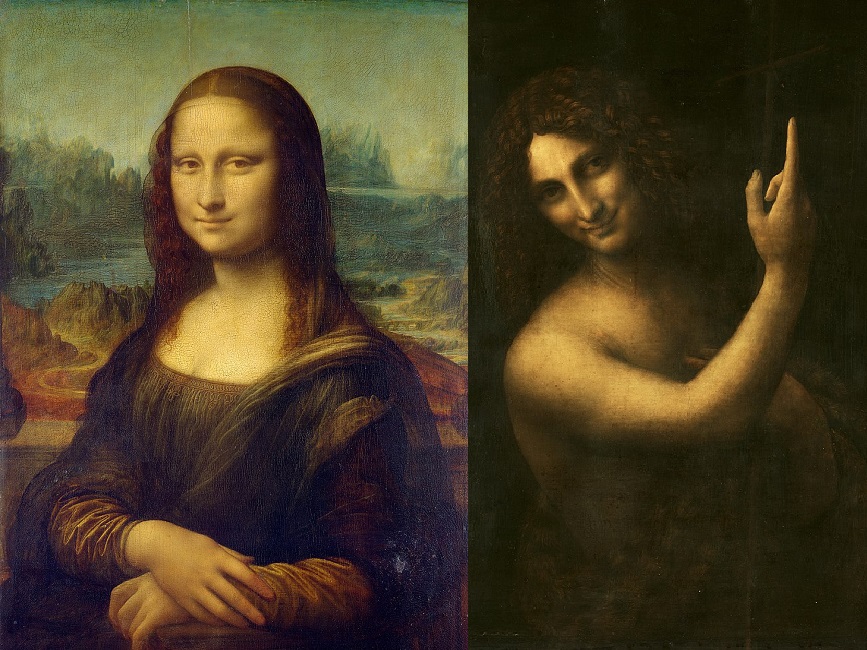
Is Lisa del Giocondo the real Mona Lisa
It was about 31 years after the death of Leonardo da Vinci that a Renaissance art historian Giorgio Vasari claimed that the painting of the Mona Lisa is Lisa del Giocondo. It is believed that after the death of Leonardo, Salaì possessed a painting which he named la Gioconda in his paper. This can be proof that there was a painting of Lisa del Giocondo but it was not enough to prove that she was the Mona Lisa, especially because it was many years after the death of Leonardo.
Furthermore, more clues were found in 2005 when a page from a copy of Cicero the ancient Roman author was discovered. The book of that page was owned by Agostino Vespucci who was a Florentine chancellery and seems to know Leonardo. In the paper, he wrote notes at the marginal corner. On that particular page where there were writings on Pelley’s ancient Greek artist, Agostino wrote a note saying he did just the same thing as Leonardo in his portrait of Lisa del Giocondo and then he marked the date October 1503. Which was the same year that Mona Lisa was painted and there is a possibility that he saw the painting and referred to it.

Who was Lisa del Giocondo?
Lisa del Giocondo born Ghevardini and married in the Giocondo family. Her husband Francesco del Giocondo was a rich silk merchant and eventually, he became a local official. He was the one who requested Leonardo to paint his wife as a celebration for their new house and second-born child. Francesco is believed to have a reputation of impatience and aggression, which could be the reason Leonardo agreeing to paint his wife. However, it can be some other reason behind Leonardo motivation to paint Lisa. It might be because he appreciated her simplicity which he actually portraits by focusing on her face and posture, her eyes mostly without any other distractions such as a big veil, jewellery and makeup. Lisa del Giocondo is believed to be the neighbour of Leonardo in Italy as well and her husband was a client of Leonardo father. This can lead to the assumption that they knew each and one lead to another, this legendary painting happens to be.
It is also believed that Leonardo brought entertainment such as music during the time of painting to cheer up Lisa. In order to get the distinctive look on her face, as it can be impossible to keep smiling for that long.
However, the biggest question is why the Mona Lisa painting stayed with Leonardo until his last breath when he was actually supposed to hand the painting to Lisa’s husband.
Two Mona Lisa
This created many assumptions that there might be more than one copy of Mona Lisa, one for Francesco and the other is in Paris. This emerges when news hit the headline in 1914. It is believed that the original was bought from a private family. Many analyses have been done to prove that there is a second original Mona Lisa but still no 100 per cent authentication. The Isleworth Mona Lisa portrait is believed to be the original one as there are pillars at the two corner sides of the portrait which is the same as Leonardo’s student Raphael painting of the Mona Lisa which was done based on the early version of the original. The face of the painting seems to be very light which might create the doubt of it being from 1503. Many other assumptions were made that there is a second copy of Mona Lisa somewhere. But it has not been fully proven of any being the original one.
In 2004, a French scientist, Pascal Cotte, used a multispectral camera to scan the Louvre Mona Lisa for an in-depth analysis. He found out that there was another painting underneath, which was Mona Lisa bigger. She seems to be closer and she was looking away instead of directly to the focus point.
This indicates that Leonardo made a portrait that he overpainted the final Mona Lisa version. This can also mean the second version is underneath the louvre one. Thus this emerges another question, why overpaint Lisa and still not give it to Francesco?
Leonardo attachment to Mona Lisa
One thing we observed was that Leonardo had lots of attachment to this particular painting as Mona Lisa was the only painting that he brought with him to France. This could lead to the assumption that maybe he painted Lisa which was the first layer. Then he wanted to keep the painting and overpaint Mona Lisa differently. But was the difference Salaì or just his imagination? There is a possibility that the Mona Lisa never existed as a person, as the painting seems to be differently posed and dress up as of woman of that time. We still don’t know which theory is the real one.
]]>In order to fully understand the difference between modern art and contemporary art, it is vital to relate the narrative of Gustave Courbet, a French painter who pioneered the Realist movement in the nineteenth century.
Most prominent painters of his period, including Courbet, questioned the Romanticism idea (you can read all about romanticism here). He stuck to his convictions of painting just what the eyes could perceive. The Cubists and Impressionists were only two of the numerous artist groups that benefited from his “independent mind,” which allowed them to grow and develop their work.
During the 1849-1850 periods, when art was still created using very conventional means, the Romanticism style became popular. This was the time when Courbet produced and presented the picture “A Burial at Ornans,” which was panned by critics due to its unusual dimensions of 10 feet by 22 feet and the fact that it did not conform to Romanticisms ‘rules’ and styles.
Critics at the time did not like the work, or message of Courbet’s painting “A Burial At Ornans”.
Rather than conforming to the art movement of the time (Romanticism) Courbet depicted this scene of his uncle’s burial in a very realistic style. Courbet painted this scene by only painting what he could see, not including emotion.
This didn’t play well with the critics, as they were keep for a piece that was part of the romanticism, which would have displayed grief and mourning, for example, but they were not shown. In contrast to traditional Romantic paintings, which depict emotions and surrealism. It maintained its reality. Instead of using painting models, he painted real individuals who were there at the funeral.
So how did this realistic painting of a funeral help the movement of modern and contemporary art?
No one could have foreseen the painting’s popularity and fame in the art world, even his friends, family, and loved ones. His distinct style cemented his reputation as the “first modern artist,” ushering in the “Modern Art Period.”
What is Modern Art?
When we hear the word “modern,” we immediately think of fresh, stylish, and fashionable items.
The style and concept of artworks created between 1890 and 1960 may be simply defined as “Modern Art.”
In other words, the style included numerous Modern Art principles while focusing more on social, economic, and political issues. This was made feasible through the employment of innovative materials and components in the creation of art. The fundamental goal of Modern Art was to put aside the conventional customs of the past and focus on a new way of recognising and evaluating the world’s present concerns.
How did Modern Art Move us Into a New Era of Art?
Many new thoughts and ideas were brought into the realm of art as a result of the modernism movement.
As a result, many painters of the time began to focus their work on dreams, symbolism, and personal iconography. Other painters began experimenting with colour and non-traditional materials.
Many well-known painters, such as Pablo Picasso, were influenced by this, and with Modernism, he created a new style of painting. It was known as cubism, and it was recognised for its geometric shapes. Then, up until the 1830s, it evolved further.
The development of art photography and film cameras gave painters new means to depict world scenes and drawings in their works.
Fauvism, Impressionism, Post-Impressionism, Dadaism, Cubism, Surrealism, Expressionism, Pop Art, and many more art forms are all characterised as part of the age of ‘Modernism.’
All of these helped to lay the groundwork for Modernism Art. A variety of elements inspired these art styles, including African and Asian art, light, culture, history, and so on.
What is Contemporary Art?
Contemporary art, by definition, is art that is created since World War II and is used to characterise the works of artists who are currently alive and making artworks.
Art critic Roger Fry formed the Contemporary Art Society in London in 1910, which was the first time the word was used.
The word was used after WWII to describe the art movement.
It was regarded by critics as a period when “modern art” was no longer relevant enough to have a beneficial impact on future generations.
The term contemporary has been used from the time of Modernism, but it was a specific form of work that did not refer to a specific historical period.
Instead, it was focused only on current events such as social, economic, and political concerns.
What are the Characteristics of Contemporary Art?
Contemporary art generated experimental pieces that addressed a broader variety of social, economic, and political concerns.
This concept mirrored current world concerns such as racism, globalisation, oppression, poverty, and feminism, to name a few. Over the last 30 years, we’ve seen an increasing number of artworks that raise awareness of the most essential and pressing issues. Video art, salons, item designs, graphical arts, and social media were all prominent.
Contemporary art also appears to be addressing and revealing new concerns that will arise in the future. One of the most noticeable distinctions between Modern and Contemporary art is this.
There are numerous venues in the globe to see and experience both modern and contemporary art for those who are interested. Take, for example, New York, one of the greatest cities in the United States, which is home to some of the most valuable museums in the country, with many magnificent masterpieces.
]]>Amrita had taken some of the paintings of Brueghel as inspiration for her paintings, too. These paintings made with such impressions were meant to be for the Hungarian market, perhaps.
While living in Hungary, Amrita Sher-Gil was used to work on larger canvases. The forms she depicted in her paintings were simple in nature and larger in size, matching the area of canvases.
There are artists who come as the birds of passage, dip their wings into the beauty of colours and then fly away to the land of fame. Amrita-Sher-Gil ( 1913 – 1941 ) was such a beautiful bird who visited the land of art for a short period and sang delightful songs on her canvases.
She would paint in daylight. Perhaps she disliked the happening of uploading the colours on canvas and the presence of artificial light. Painting the Indian women at work, especially the women and girls living were her preferred subject. In any case, she would not allow anyone to look at her painting before it is completed. The name of this artist was Amrita Sher-Gill
Indian Art: In India, The Bengal school of artists has done a revolution in the field of arts and culture. It helped to reshape the modern taste among the Indian people in general and the Artists in particular.
The movement in the modern art sector made Indian artists aware of their own heritage. Amrita Sher-Gil’s paintings help to make the modern Indian painting a talk of the international art market.
The Artist: Amrita Sher-Gil was a child of the cross country marriage, Indian father and Hungarian mother. Born in Hungary, she had the opportunity to paint European landscapes at an early age. While studying art in Paris, she drew inspiration from the art of Paul Cezanne and Paul Gauguin. Perhaps, her alter-ego, to be felt as being an India girl, was to spring out in future. She portrayed an India woman, in a manner as if she wanted to relive his life through the women she painted.
The Subjects: On returning to India she painted the subjects lying on the Indian landscape. Amrita Sher-Gil, though initially inspired by the Post Impressionists, painted canvasses depicting the life of the ordinary people of India. Women living in the hill area of Northern India was her favourite subject.
In such a costume and appearance, she would make her studio looking more austere and painterly. And with her hair pulled tightly back, she completed the stark and austere atmosphere which prevailed in her studio.
Amrita painted in a realistic style, as she had got her art education in that field. But after painting Three Girls, her style had changed. The painting became flatter and colours turned richer. In this painting, she had depicted three girls of marriageable age. The general feel of the painting is beauty and dignity. After this painting, Amrita had painted several frames on the subjects depicting women.
The talent of using colours on canvas is not enough to portray the native people; an artist must have some attachment and knowledge about the real life of the people he or she is portraying. Amrita had the same. And she hat it very deeply. She built up her artistic career on the grace and beauty of the hill women, which were living around her.
The virgin beauty and modesty of Indian girls and women elegantly painted by Amrita Sher-Gil are the most attractive features of her paintings. The colours Amrita used depicting the pattern of the girls’ sitting or standing postures had helped to show movements in the paintings. Her artworks witness the Indian culture in its essence.
Amrita’s Personal Life: In her personal life, Amrita liked to be seen as glamorous and socialite. she was like this and she wanted to be seen like this. But she had a special choice: she would wear a large coat made from rough cloth while painting in her room. her hairstyle was perfectly Indian. It was her habit and she was fond of keeping her hair tightly pulled on the backside. this is the typical style of Indian women, for keeping the hair stock.
]]>The french women had felt the painting they saw and they produced several masterpieces, too. Let us talk about some of the prolific women painters. It is said that the paintings are to be seen and not to be talked about. But we are to talk about the paintings done by the women artists.
Let us start talking about the women artist of France. Woman artists of France, who lived in the eighteenth century. Let us start. Let us start with some of the renowned portrait-makers women artists.
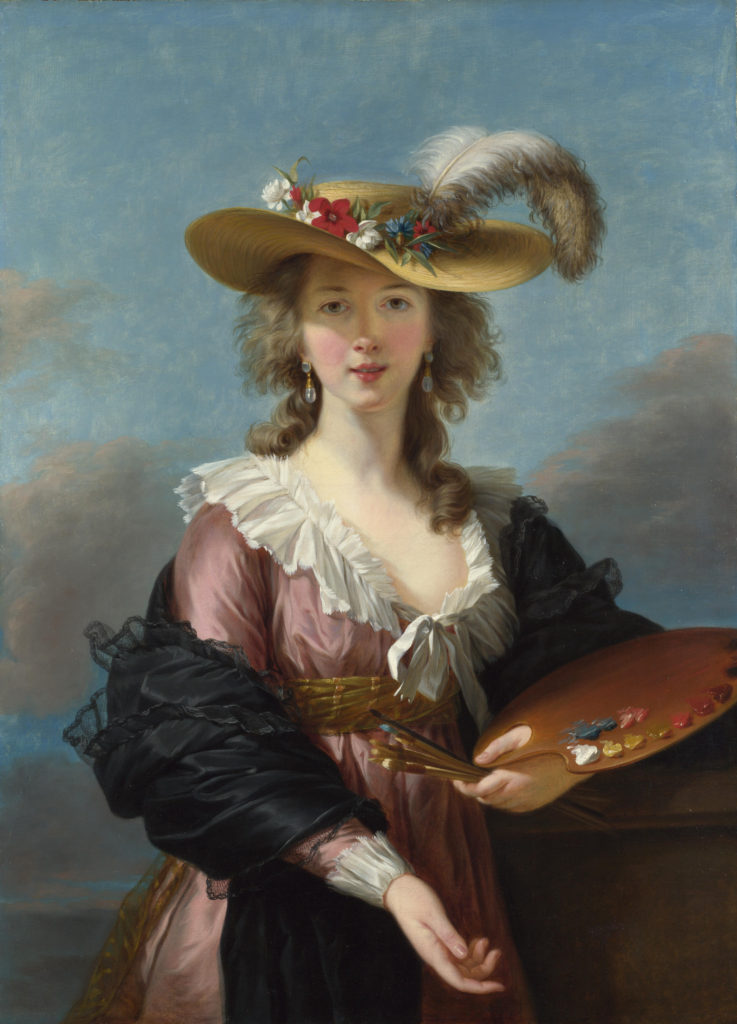
Self Portrait in a Straw Hat
Élisabeth Louise Vigée Le Brun
Oil on Canvas,
National Gallery, Central London
Élisabeth Louise Vigée Lee Brun (1755-1842):
She was known as Madame Lee Brun, among the artists and her friends. She started her painting career early, in her teenage. But what deed she painted? she painted beautiful flowers. She painted beautiful people.
Yes, she had painted more than 600 portraits. The landscape was her favourite subjects. She had a collection of 200 landscapes. Presently, her paintings are displayed in major museums of the world.
Look at the portrait of Mohammed Dervish Khan. This painting was sold for $7.2 Million at Sotheby, in the year 2019. This sale of the portrait by Élisabeth Louise Vigée Le Brun has set a world record for a woman artists who lived before 1900.
Elisabeth had the opportunity to travel to the Netherlands, with her husband. There she observed the paintings of Flemish master artists. The Self-Portrait with Straw Hat (1782) given at the top is by Elisabeth. For this portrait, we can see that she would have got inspiration from the work of Peter Paul Ruben.
The State Hermitage Museum, Saint Petersburg, Russia; National Gallery, Central London; Metropolitan Museum of Art, New York City: these are the museums that have displayed the paintings of Madama Lee Burn. There were contemporary artists, too, who had painted portraits in the style and poses Elisabeth had done.
Look at the self-portrait of one contemporary woman artist of France, Adélaïde Labille-Guiard (1749 – 1803). We can see the influence of Elisabeth’s painting given above, in Adélaïde Labille-Guiard’s self-portrait.
Adélaïde was a wonderful artist on her own. She had painted a number of portraits and miniature portraits, too. After the French revolution, the paintings of women were also allowed to be displayed their work freely.
Adélaïde’s works had been also displayed in several exhibitions and museums. in Salon. Marie had displayed her paintings in Salon, too.

Painting of a female violinist
Anne Vallayer-Coster
Oil on canvas National Museum of
Fine Arts, Stockholm, Sweden
Anne Vallayer-Coster:
There was a river Bievre, near the river Seine. There was the home of a goldsmith. He had a golden connection with the royal family of France. Anne was born in 1744 as one of the four daughters of the said Goldsmith. Her father had a business of tapestry. Her artwork had found a way onto the tapestries produced in her father’s factory.
In eighteenth-century France, portrait painting and still-life paintings were not considered first-grade art. However, Anne accepted the challenge and created marvellous portraits. Once her family moved to Paris, her portraits and other still-life were in good demand.
Anne had friends in Royal families. But once the royal family was on the decline of its influence, Anne had suffered a setback, too. It was the days that the women were subjected to several restrictions. Art institutions were not allowing women to learn art, too. The display of the painting in a gallery was a rare event.

Self-portrait with a Harp
Oil on Canvas Rose-Adélaïde Ducreux
Metropolitan Museum of Art of New York City
Rose-Adélaïde Ducreux (1761-1802):
She was a French painter. She was a musician, too. She was born in Paris at the time of the French revolution. It was the brightest of the times in France; It was the darkest of the times in France. However, the French women and men artists kept the bell of painting ringing. Rose was one of them.
The self-portrait shown here is painted using oil on canvas. However Rose used paster colours very artistically. Here in this self-portrait, the artist is depicted along with her musical instruments. Rose had used such a colour scheme in her paintings that the viewers would find them very light and gentle to the eye.
Rose had made her debut at the Louvre Salon. It was the year 1791 when Rose had submitted this portrait Self-portrait with a Harp, wherein she was playing the harp. This painting is presently displayed in the Metropolitan Museum of Art, New York City, USA. [All the images are in Public Domain, taken from Wikimedia Commons]
Courtesy: www.paintingsgalleries.com
]]>There is a strong correlation between art and film. Film is a form of art itself and in fact it is one of the most advanced forms of art created by man. Some of the generalized purposes of art and film that unite them are to create a powerful emotional experience, to entertain and to educate.
Over the years Hollywood and European filmmakers have created hundreds of amazing films about artists and their works that inspire audience to appreciate art and learn more about the life story of some brilliant people.
If you would like to follow the life of the fabulous painter like Frida Khalo or to learn the story of Modigliani read our article to choose the best film for you!
1. Frida (2002)

The beautiful film Frida (2002) directed by Julie Taymor portraits a private life of the surrealist Mexican painter Frida Kahlo. (Salma Hayek) The film captivates the audience by its beauty, sensitivity and art.
The story starts with Frida being involved in a bus crash at the age of 18. Though she survived her injuries, they caused her severe pain and extended periods of isolation for the rest of her life – greatly influencing her work, which most often took the form of self-portraits.
The film includes her complicated and up and down relationship with fellow artist and twice husband Diego Rivera (Alfred Molina), her affair with exiled Russian Marxist revolutionary Leon Trotsky (Geoffrey Rush), her constant health struggles, her amputations, her miscarriages, and her bi-sexuality.
The film Frida breathed life into the story of an incredible individual, who overcame enormous obstacles to create extraordinary art.
2. Modigliani (2004)

The film is set in 1919 Paris and depicts a story about the Italian artist Modigliani and his tragic romance with Jeanne Hebuterne.
The film focuses on his last days as well as the vicious rivalry between two brilliant people Modigliani and Picasso. His bitter rivalry with Picasso is one of the story’s primary threads.
The message of the film is clear: Modigliani’s belief in his work and his passion for art are unconditional. No one can touch them, not even Picasso.
The film is brilliantly acted by Andy Garcia, Omid Djalili and Elsa Zylberstein. Emotional, tense, and a wonderful show of art, this film is worth a watch.
3. Loving Vincent (2017)

This visually stunning, beautiful piece of film is a must-watch. It’s an animation imagining the last months of Dutch painter Vincent Van Gogh. (Robert Gulaczyk)
Directed by Dorota Kobiela and Hugh Welchman the film explores the life and the unusual death of Vincent Van Gogh.
The most amazing point of this film is that each of 65,000 frames has been painted by hand and in Van Gogh’s post-impressionist style by 125 painters. The whole process took 10 years to complete. The technique literally gave life to Van Gogh’s paintings.
4. Big Eyes (2014)
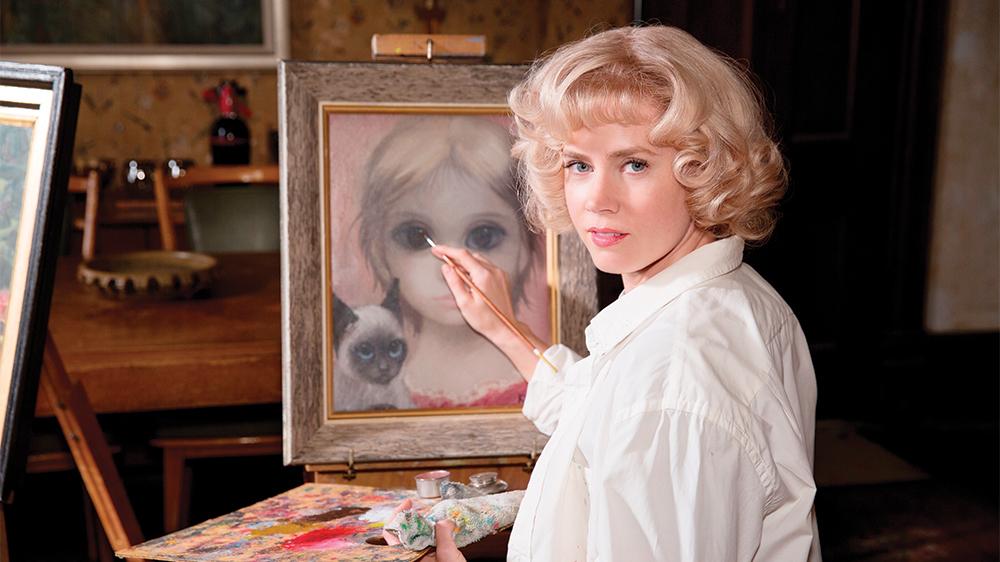
Directed and produced by Tim Burton, Big Eyes is based on the true story of Walter Keane (Christoph Waltz), who was one of the most successful painters of the 1950s and early 1960s.
The film tells us the story of the artist who became overwhelmingly notorious by his enigmatic paintings of waifs with big eyes. His paintings became a sensation, generating huge earnings and achieving bizarre popular icon status. The truth would eventually be discovered though: Keane’s art was actually not created by him at all, but by his wife, Margaret (Amy Adams).
Big Eyes centers on Margaret’s awakening as an artist, the phenomenal success of her paintings, and her tumultuous relationship with her husband.
“Big Eyes” is full of fascinating questions about the meaning of art, the concept of popularity, and what it means to develop a huge audience.
5. The Agony and Ecstasy (1965)
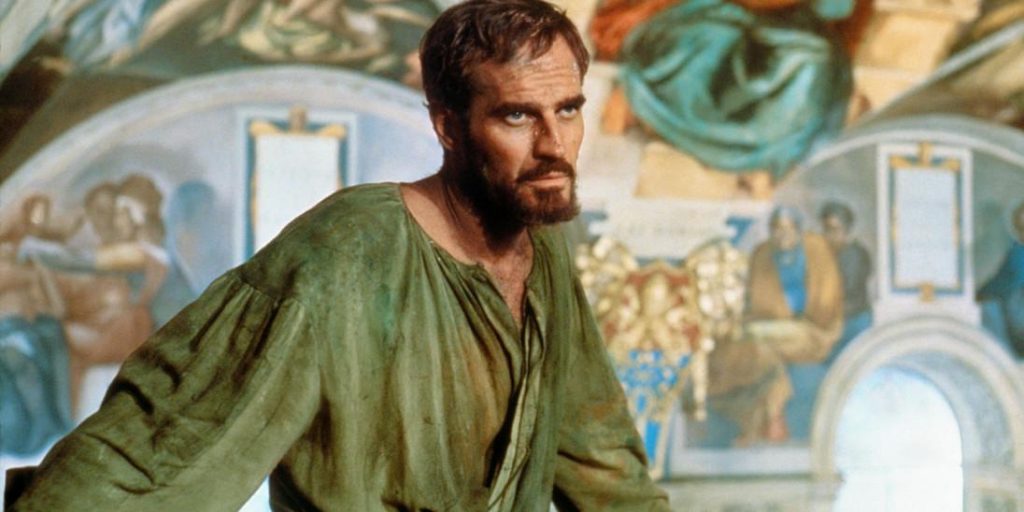
The Agony and the Ecstacy is the story of the 16th century war of wills between Renaissance artist Michelangelo (Charlton Heston) and Pope Julius II (Rex Harrison).
The story itself is really interesting as it opens up the many challenges Michelangelo experienced in completing his famous painting and this from a man who did not consider himself a painter but rather a sculptor. Charlton Heston plays a strong Michelangelo with a temper, and Rex Harrison is terrific as the pope.
The film will please art and history admirers and leave a wonderful aftertaste.
6. Caravaggio (1986)
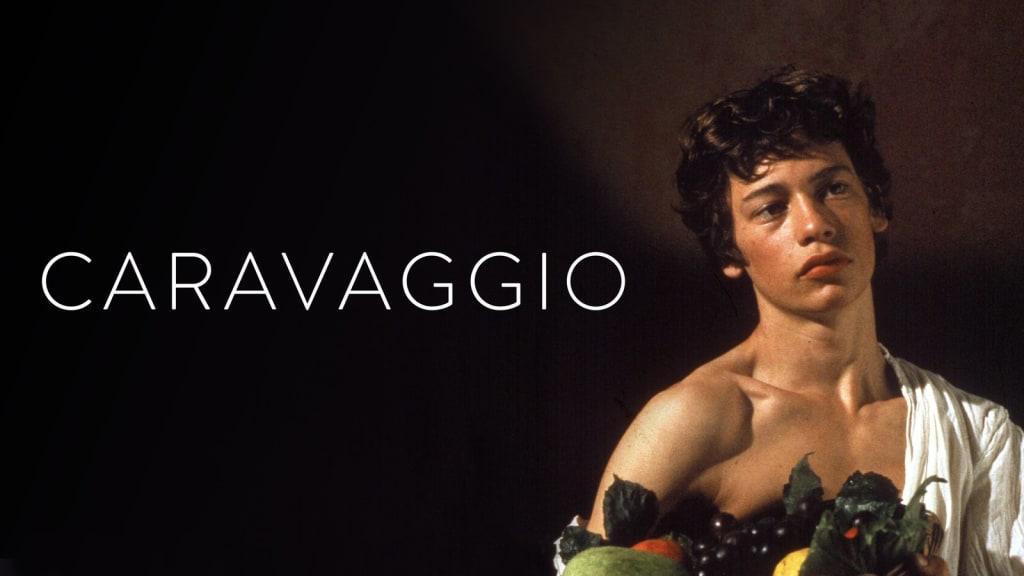
Caravaggio is biographical film which depicts us an adventurous life of a baroque painter Michelangelo Merisi da Caravaggio (Nigel Terry) who became much more renown as Caravaggio. It is actually a town near Milan in Italy where the painter came from.
The film paints the biographical details, from his boyhood apprenticeship in Milan, escape to Rome, and patronage from the Cardinal Francesco Del Monte and the notorious taste of Caravaggio for street fights and carousing.
Film is expressionistic and engaging, and will make you understand the nature of the artist named Caravaggio.
7. Death and Maiden (2016)
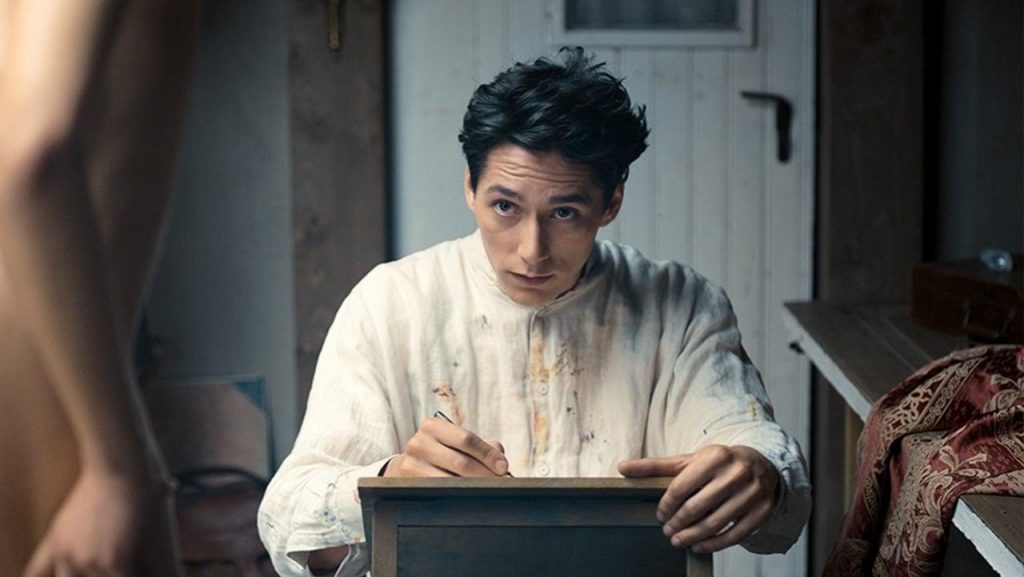
Death and Maiden is a biopic about Egon Schiele, one of the most provocative artists from Vienna at the beginning of the 20th Century.
“Death and Maiden” is a painting of a 17 year old Wally, who is arguably artist’s true love who became immortalized in it.
Egon Schiele’s radical paintings scandalize Viennese society but notable and fearless artist as Gustav Kilmpt sees them as exceptional.
The film portrays Egon Schiele as an artist who leaves a vast legacy to this world after his own ephemeral and turbulent life.
8. Basquiat (1996)

Basquiat is set in New York 1980s and tells us a story of of the life and suffering of Jean-Michel Basquiat (played by Jeffrey Wright) an American artist of Haitian and Puerto Rican descent born in 1960.
The film depicts his life as a street artist who actually lived on the streets, his discovery by Andy Warhol (David Bowie) and others, how he became an in-demand graffiti and neo-expressionist artist, and his death from a drug overdose at his art studio at the age of 27.
The film vividly re-creates the 1980s New York art scene from firsthand experience.
9. Pollock (2000)
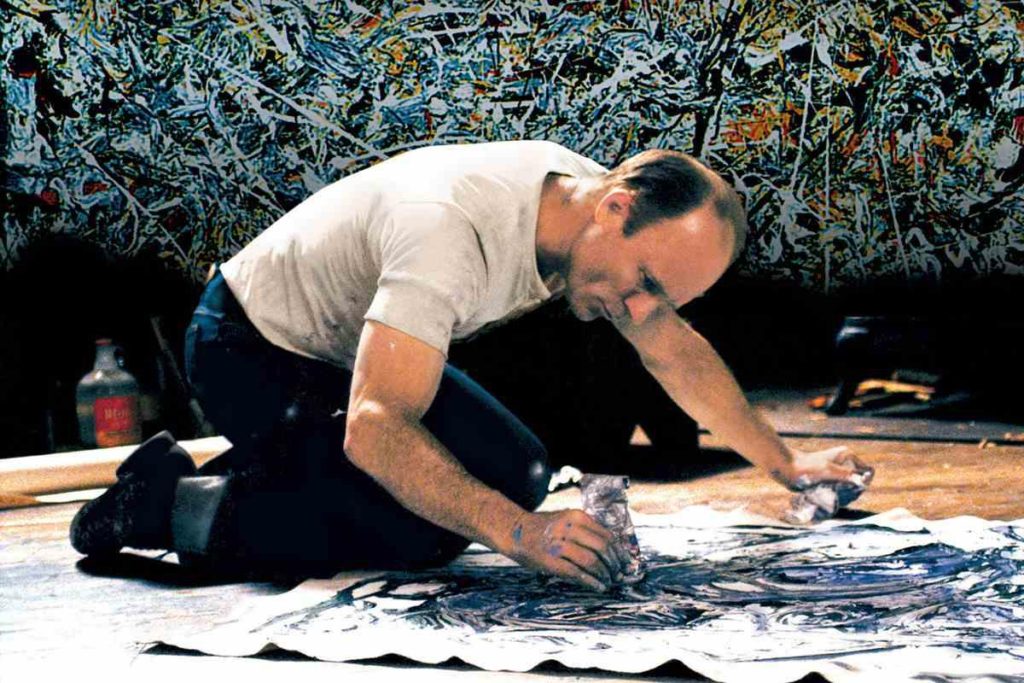
Pollock depicts the life of the American abstract expressionist painter Jackson Pollock.
The film portraits a life journey of Pollock from struggling artist to international success and enfold his battle with alcoholism and his death in a car crash.
The director of the film is Ed Harris who also played a part of Jackson Pollock and earned Oscar for “Best Actor”.
Jackson Pollock was known for his drip paintings, which have become some of the most expensive works ever sold.
10. Séraphine (2008)

Seraphine directed by Martin Provost was a critically acclaimed film and the winner of seven Césars – the French Oscars – including best film.
The life of French painter Séraphine Louis was portrayed in this biopic . Working as a cleaning lady, Séraphine ( Yolande Moreau) was discovered and promoted by German art collector Wilhelm Ude (Ulrich Tukur) and later became a famous representative of the Naïve art movement with her works featuring intensely repeated floral arrangements.
She famously incorporated in her paintings such materials as soil and the blood of dead animals, which she found on her daily walks.
]]>
Investing in art doesn’t just add to your home décor, it makes you more introspective. If done correctly, it can also drastically increase your net worth. According to recent studies, the price of art has gone up more than 1000per cent in the past four decades. Even so, the primary question that strikes the mind of someone who has never bought art is: is it a safe investment option? The answer is simple: just like any other investment, you need to first educate yourself about the intricacies of the industry and know about the pros and cons of any niche.
So, how to go about it? First, you need to understand that ‘art’ does not just refer to paintings but includes a variety of disciplines such as sculpture, drawings, sequential art and photography. There are many more but when you’re thinking about investing in art, you should:
Study the Artist
It is extremely important to perform detailed research about the artist. Age, education, and previous exhibitions and awards should be known. This can’t be done just by browsing the internet; you will have to actually visit galleries and understand what sells in the contemporary market.
Research the Artwork
The primary question is: how to tell whether a painting is a real or a fake? This isn’t usually a problem if the artist is alive, but if it is a Picasso or a Da Vinci, or any deceased artist, you should obtain a certificate of authenticity from an expert and get it appraised.
Investigate the Dealer
Purchasing art involves a great deal of scrutiny, and the market is such that it is extremely difficult to know the reputation of dealers and brokers. It’s much more feasible to find out a gallery’s reputation.
Where to Buy Art
There are many options. Auctions are exciting, but it is extremely important to stay cautious as you’re not just paying out of passion but also thinking of it as an investment. So, you need to be certain of its value, weigh price and condition, and bid accordingly. Also, you need to know that 10% to 30% can be added to your final bid. Galleries are very different – they provide a relaxed environment in which buyers can take their time to understand, introspect and purchase.
But if you are entirely new and sceptical, perhaps you should start with art fairs as they have more variety at lower prices, and usually prove to be great learning grounds for art.
Reselling
It is extremely important to take good care of your art as it matters greatly while fixing its resale value. Keep it away from a fireplace or damp, humid rooms – these are basic. Also, a timely revaluation will enable you to know its current worth before selling it.
While investing in art, it is most important to understand whether you are buying for passion or investment. That demarcation is paramount and will lead to making the art more profitable.
Akshaypat Singhania
Chairman & Managing Director of JK International and Director of JK Organisation
Back in the day you had priests and philosophers and all sorts of other intellectuals – who were usually close to the ruling monarch – that helped shape what people of their time thought of as good or bad. With strong slogans like: “Pagans are bad.” “The king is great.” “Our culture is good, but the culture of our neighbouring country, well, not so much.” and many more, all inevitably leading to some form of action against the proclaimed bad and towards the perceived good.
And those who’s job it was to communicate such decisions were the creative elite, selected by the king or leading counsel to share the “right” and “just” views to all the peoples of the country. From church paintings to Stalins propagandists, their job was to transform wishes of the ruling class into an emotional and influential message that the peasants and proletariat could understand.
But in 2018, well, the idea of influence has been taken (or borrowed indefinitely) by companies, and as an interesting byproduct, they have taken the questions of morality along for the ride; just think about the important factors of today’s businesses for consumers, one of the first on the list on average is business ethics, not price or performance.
And now because of this change of influence from politician to business owner(s), I feel that we creatives are headed towards an interesting time. Now, it isn’t the government or the king and queen that have the greatest need for sharable or authoritative messages in form of sculptures, portraits, flyers …, but Google, Apple, Nike and Amazon. And all the millions of smaller companies of today. If in the past the creative could (or had to) serve or revolt against his or her government, now we are coming into a time where the people who rule do not need flags, insignias or speeches, but logos, corporate identities and copyrighting.
]]>Many of us may be familiar wit the book Steal Like an Artist by written by Austin Kleon. In this book he describes how countless famous artists have been “stealing” other artists styles, ideas and just about anything else that they deemed valuable and used everything in their own work. But apart from a marketer’s standpoint, should this really be called stealing?
Copyright law is a complex topic that differs from country to country and I am neither a lawyer nor a Mike Ross (smart person with eidetic memory — for anyone, who doesn’t watch Suits), so I surely won’t be fooling myself or anyone by talking about it, but if anyone is interested The Future have a great video on creative copyright (focusing on the US but some things are the same everywhere), where they explore what we creatives can and shouldn’t do with other people’s work.
But I am more than willing and able to offer a sort of anecdote instead: In 2014 an artist know for his tendencies to “appropriate” the works of others (the guy who copied Marlboro’s Cowboy photographs and exhibited them as art), decided to take screenshots of other people’s Instagram accounts and go to town with them. And by town I mean have an exhibition at Gagosian called “New Portraits” and selling these works for around 100.00$ each.
He, of course, was then sued by several people and the lawsuit has been ongoing with a strong possibility that Prince will win his claim, namely that one doesn’t need to change a work of art to make it into a different work of art. One needs only change the context of said work of art and its meaning, message and value change because of it.
I must state beforehand I am a fan of his work intellectually speaking, and that I can’t say my views on what he does are by any means unbiased (though I do not condole stealing of any kind), and I wish to present them as objective as I can. What Richard Prince does is quite unique in the art world; he blatantly yet smartly plays with our understanding of what it means to own and to create a work of art. He is a strong supporter of breaking the status quo and probably (judging from his books) quite a bit of a nihilist deep down. But in the end, he does get one thing:
If I paint an apple tree painting and hang it inside a church or if I take the same painting and hang it on the wall of a cabin inside an orchard, I might have had the same work of art physically, but the entire meaning of this piece changes drastically when it is hung in one place or the other. It isn’t only the work that produces its meaning by itself, it’s the entire space (that’s why white cubes were so popular, and still are, because they take everything that isn’t the art piece away so that only the true meaning of each art piece is presented).
So while Richard may really be taking the literal images of other people’s works and showing them as his own, he technically isn’t stealing the physical objects. The only thing he is taking is the outer shell of the objects (or images) in question. And while I am not defending his actions, it is incredibly interesting where various types of artists see the line between stealing something and borrowing or transforming it (or appropriating as we artists like to soften up the word steal when writing essays).
If I take anything, physical or not (mp3 music and ebooks for example) and use it in the same way it was intended: the context of reading a bought book and a stolen book is roughly the same – both times I read it the same way with the same intent of reading it – the context of listening to a bought album of Metallica and a torrented one is roughly the same – both times I listen to it in the same way, again with the same intent of listening to the tunes.
But if I take the music of Metallica and play it over a humorous scene in a movie (not that anyone would), my intent changes and with it the message and function of let’s say Enter Sandman goes from communicating the scary movie feeling we know and love to creating a weird feeling of satire in combination with, lat’s say people getting pies in their faces. But can Metallica sue me if I used their song in such a way, even if I say that it’s made by Metallica? The music Industry said yes, but funny enough if I take a part of Harry Potter, and I mean word for word, and use it in my book, but I use the appropriate citation and change it’s meaning from telling a story about a wizard, to let’s say a book about peoples imagination, J. K. Rowling can’t sue me.
So while the music example is as clear as day to all of us, it becomes a bit more confusing when talking about books, and it gets even more when talking about Fine Art, yet the principles are the same. Some say you can’t steal other peoples work while others will tell you there is absolutely no stealing going on. But what’s your view on using other people’s work, is it something you do regularly or would you never brake the sacred vows of creative integrity?
]]>Degas began by copying Italian Renaissance paintings at the Louvre and trained in the studio of Louis Lamothe, who taught in the traditional academic style, with its emphasis on line and its insistence on the crucial importance of draftsmanship. Degas was also strongly influenced by the paintings and frescoes he saw during several long trips to Italy in the late 1850s; he made many sketches and drawings of them in his notebooks.
Evidence of Degas’ classical education can be seen in his relatively static, friezelike early painting, Young Spartans Exercising (ca. 1860; National Gallery, London), done while he was still in his twenties. Yet despite the title, and the suggestion of classical drapery on some of the figures in the background, there is little that places the subject of this painting in ancient Greece. Indeed, it has been noted that the young girls have the snub noses and immature bodies of “Montmartre types,” the forerunners of the dancers Degas painted so often throughout his career. After 1865, when the Salon accepted his history painting The Misfortunes of the City of Orléans (Musée d’Orsay, Paris), Degas did not paint academic subjects again, focusing his attention on scenes of modern life. He began to paint scenes of such urban leisure activities as horse racing and, after about 1870, of café-concert singers and ballet dancers.
]]>At the age of 40, Sir Winston Churchill found himself at a career low: After the World War I attack he ordered on Gallipoli, Turkey, went horrifically awry, he was demoted from his role as First Lord of the Admiralty in May 1915. He resigned from his government post and became an officer in the army. Deflated of power and consumed with anxiety, he took up an unexpected new hobby: painting.
“Painting came to my rescue in a most trying time,” Churchill would later write in the 1920s, in essays that would become a small book, Painting as a Pastime. The hobby became, for the great British statesman, a source of delight and a respite from the stress of his career. He would eventually create over 550 paintings, crediting the practice with helping him to hone his visual acuity, powers of observation, and memory. The pastime would flourish, and perhaps even aid him, as he furthered his career as a world-renowned writer, orator, and political leader.
Churchill first picked up a brush at the suggestion of his sister-in-law, Lady Gwendoline Bertie, who was also a painter. In Painting as a Pastime, he recalled his first artmaking attempt one day in the countryside. Intimidated by the blank canvas before him, he diffidently placed a pale blue daub of paint on its surface to begin the sky, and was soon interrupted by the arrival of Glasgow painter Sir John Lavery and his wife, Hazel. The latter exclaimed, “Painting! But what are you hesitating about?” She grabbed a brush and made “large, fierce strokes and slashes of blue on the absolutely cowering canvas.” With that, Churchill wrote, “I seized the largest brush and fell upon my victim with Berserk fury. I have never felt any awe of a canvas since.”
In the five decades that followed, Churchill was prolific, primarily focusing on landscapes and seascapes made en plein air. And despite his incessant claims that he was merely an amateur, he developed an admirable flair for the art.
“His approach was very simple: Go outside and paint what you see,” Duncan Sandys, Churchill’s great-grandson, told Artsy. “He did it for fun; he didn’t take his paintings very seriously.”
Churchill was most fond of oils, for their forgiving, flexible nature and bright colors—as well as the joy they exuded. “Just to paint is great fun,” he wrote. “The colours are lovely to look at and delicious to squeeze out.”
He was known to set up his easel outdoors to capture the grounds of his country home in Kent, called Chartwell. (Now owned by the National Trust and open to visitors today, it still houses Churchill’s preserved painting studio.) The politician-painter would also work during his travels to Egypt, Italy, Morocco, and the south of France, among other locations.
While a proclivity for outdoor subjects prevailed, he also tried his hand at still lifes and portraits, with varying degrees of success. Churchill’s works read as somewhat intimate snapshots, illustrating his favored travel destinations, holidays, and family members. On the whole, his subjects appear decidedly positive, communicating the pleasure he got out of depicting them.
Churchill was largely self-taught, and adamant that formal art lessons were a young person’s game. The thing he and his like-minded amateur peers needed most, he believed, was a certain kind of passion.
“We cannot aspire to masterpiece,” he wrote. “We may content ourselves with a joy ride in a paint-box. And for this Audacity is the only ticket.”
Nevertheless, he was keen to improve his technique, and did so by taking cues from leading artists. He admired the work of Impressionist and Post-Impressionist masters like Édouard Manet, Claude Monet, Paul Cézanne, and Henri Matisse, and was even known to travel to the same locations where they had painted years before, seeking out the light and land that had proven inspirational.
]]>